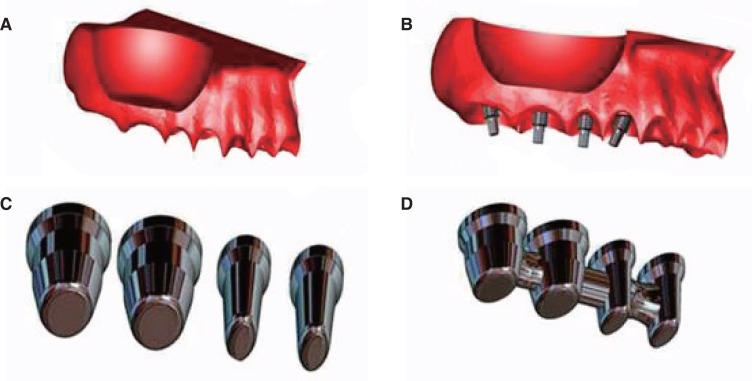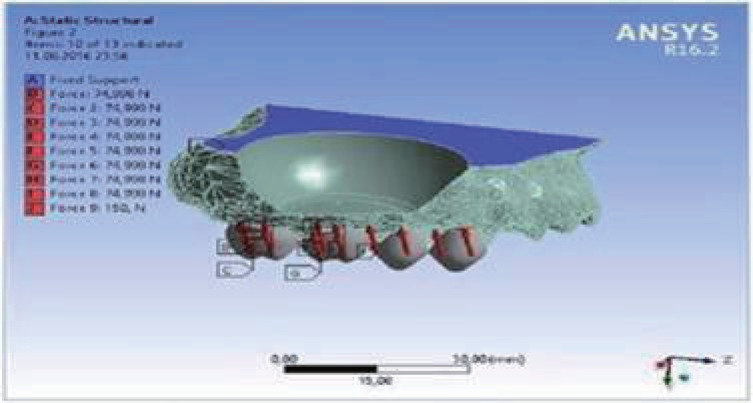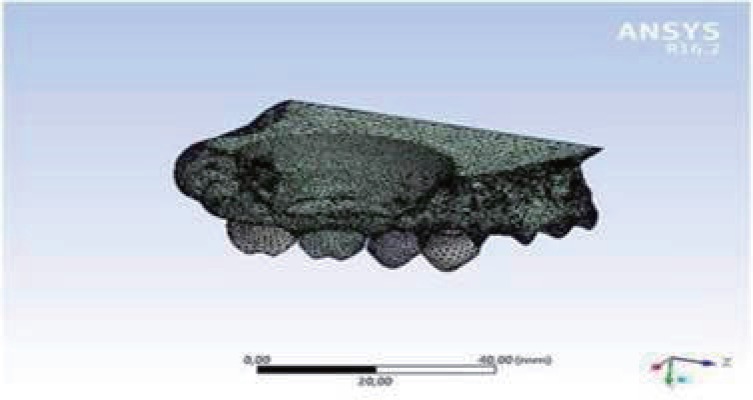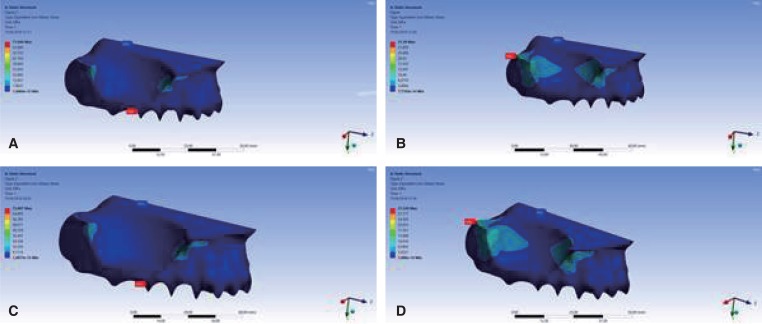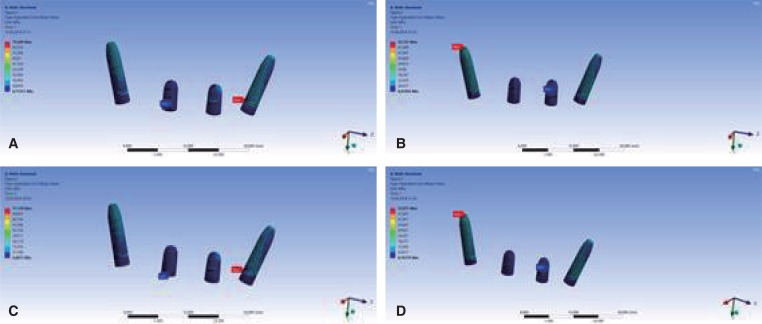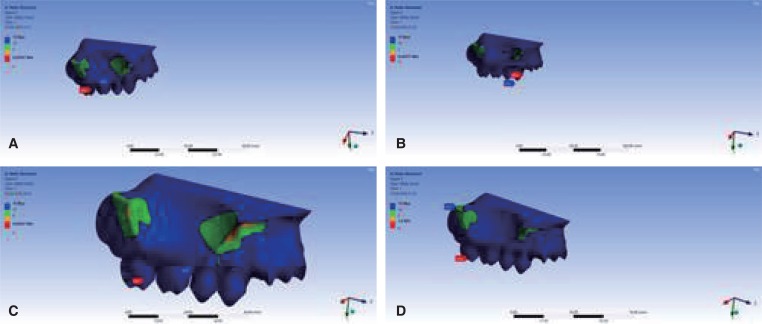J Adv Prosthodont.
2019 Apr;11(2):112-119. 10.4047/jap.2019.11.2.112.
Evaluation of reliability of zirconia materials to be used in implant-retained restoration on the atrophic bone of the posterior maxilla: A finite element study
- Affiliations
-
- 1Department of Prosthodontics, Faculty of Dentistry, Bolu Abant Izzet Baysal University, Bolu, Turkey. dtkubradegirmenci@outlook.com
- 2Department of Prosthodontics, Faculty of Dentistry, Kocaeli University, Kocaeli, Turkey.
- 3Department of Mechanical Engineering, Faculty of Engineering, Marmara University, Istanbul, Turkey.
- KMID: 2444145
- DOI: http://doi.org/10.4047/jap.2019.11.2.112
Abstract
- PURPOSE
Zirconia materials have been used for implant-retained restorations, but the stress distribution of zirconia is not entirely clear. The aim of this study is to evaluate the stress distribution and risky areas caused by the different design of zirconia restorations on the atrophic bone of the posterior maxilla.
MATERIALS AND METHODS
An edentulous D4-type bone model was prepared from radiography of an atrophic posterior maxilla. Monolithic zirconia and zirconia-fused porcelain implant-retained restorations were designed as splinted or non-splinted. 300-N occlusal forces were applied obliquely. Stress analyses were performed using a 3D FEA program.
RESULTS
According to stress analysis, the bone between the 1) molar implant and the 2) premolar in the non-splinted monolithic zirconia restoration model was stated as the riskiest area. Similarly, the maximum von Mises stress value was detected on the bone of the non-splinted monolithic zirconia models.
CONCLUSION
Splinting of implant-retained restorations can be more critical for monolithic zirconia than zirconia fused to porcelain for the longevity of the bone.
Keyword
MeSH Terms
Figure
Reference
-
1. Eazhil R, Swaminathan SV, Gunaseelan M, Kannan GV, Alagesan C. Impact of implant diameter and length on stress distribution in osseointegrated implants: A 3D FEA study. J Int Soc Prev Community Dent. 2016; 6:590–596. PMID: 28032053.
Article2. Şeker E, Ulusoy M, Ozan O, Dogan D, Kusakci seker B. Biomechanical effects of different fixed partial denture designs planned on bicortically anchored short, graft-supported long, or 45-degree-inclined long implants in the posterior maxilla: A three-dimensional finite element analysis. Int J Oral Maxillofac Implants. 2014; 29:e1–e9. PMID: 24451875.
Article3. Testori T, Del Fabbro M, Capelli M, Zuffetti F, Francetti L, Weinstein RL. Immediate occlusal loading and tilted implants for the rehabilitation of the atrophic edentulous maxilla: 1-year interim results of a multicenter prospective study. Clin Oral Implants Res. 2008; 19:227–232. PMID: 18177428.
Article4. Almeida EO, Rocha EP, Freitas Júnior AC, Anchieta RB, Poveda R, Gupta N, Coelho PG. Tilted and short implants supporting fixed prosthesis in an atrophic maxilla: a 3D-FEA biomechanical evaluation. Clin Implant Dent Relat Res. 2015; 17:e332–e342. PMID: 23910435.
Article5. Fortin Y, Sullivan RM, Rangert BR. The Marius implant bridge: surgical and prosthetic rehabilitation for the completely edentulous upper jaw with moderate to severe resorption: a 5-year retrospective clinical study. Clin Implant Dent Relat Res. 2002; 4:69–77. PMID: 12121606.
Article6. Zhang G, Yuan H, Chen X, Wang W, Chen J, Liang J, Zhang P. A three-dimensional finite element study on the biomechanical simulation of various structured dental implants and their surrounding bone tissues. Int J Dent. 2016; 2016:4867402. PMID: 26904121.
Article7. Lan TH, Liu PH, Chou MM, Lee HE. Fracture resistance of monolithic zirconia crowns with different occlusal thicknesses in implant prostheses. J Prosthet Dent. 2016; 115:76–83. PMID: 26412004.
Article8. Pozzi A, Holst S, Fabbri G, Tallarico M. Clinical reliability of CAD/CAM cross-arch zirconia bridges on immediately loaded implants placed with computer-assisted/template-guided surgery: a retrospective study with a follow-up between 3 and 5 years. Clin Implant Dent Relat Res. 2015; 17:e86–e96. PMID: 23910539.
Article9. Cheng CW, Chien CH, Chen CJ, Papaspyridakos P. Clinical results and technical complications of posterior implant-supported modified monolithic zirconia single crowns and shortspan fixed dental prostheses: A 2-year pilot study. J Prosthodont. 2018; 27:108–114. PMID: 29086467.10. Abdulmajeed AA, Lim KG, Närhi TO, Cooper LF. Completearch implant-supported monolithic zirconia fixed dental prostheses: A systematic review. J Prosthet Dent. 2016; 115:672–677. PMID: 26809220.
Article11. de Souza Batista VE, Verri FR, Lemos CAA, Cruz RS, Oliveira HFF, Gomes JML, Pellizzer EP. Should the restoration of adjacent implants be splinted or nonsplinted? A systematic review and meta-analysis. J Prosthet Dent. 2019; 121:41–51. PMID: 29961632.
Article12. Toniollo MB, Macedo AP, Pupim D, Zaparolli D, da Gloria Chiarello de Mattos M. Finite element analysis of bone stress in the posterior mandible using regular and short implants, in the same context, with splinted and nonsplinted prostheses. Int J Oral Maxillofac Implants. 2017; 32:e199–e206. PMID: 28708912.
Article13. Yan X, Zhang X, Chi W, Ai H, Wu L. Comparing the influence of crestal cortical bone and sinus floor cortical bone in posterior maxilla bi-cortical dental implantation: a three-dimensional finite element analysis. Acta Odontol Scand. 2015; 73:312–320. PMID: 25330164.
Article14. El-Anwar MI, Yousief SA, Soliman TA, Saleh MM, Omar WS. A finite element study on stress distribution of two different attachment designs under implant supported overdenture. Saudi Dent J. 2015; 27:201–207. PMID: 26644755.
Article15. Li T, Yang X, Zhang D, Zhou H, Shao J, Ding Y, Kong L. Analysis of the biomechanical feasibility of a wide implant in moderately atrophic maxillary sinus region with finite element method. Oral Surg Oral Med Oral Pathol Oral Radiol. 2012; 114:e1–e8.
Article16. Archangelo CM, Rocha EP, Pereira JA, Martin Junior M, Anchieta RB, Freitas Júnior AC. Periodontal ligament influence on the stress distribution in a removable partial denture supported by implant: a finite element analysis. J Appl Oral Sci. 2012; 20:362–368. PMID: 22858705.
Article17. Tsouknidas A, Giannopoulos D, Savvakis S, Michailidis N, Lympoudi E, Fytanidis D, Pissiotis A, Michalakis K. The influence of bone quality on the biomechanical behavior of a tooth-implant fixed partial denture: A three-dimensional finite element analysis. Int J Oral Maxillofac Implants. 2016; 31:e143–e154. PMID: 27861651.
Article18. Wheleer MA. Dental anatomy, phisology and occlusion. 8th ed. St. Louis: Elsevier;2010. p. 216. p. 230. p. 264. p. 280.19. Massoumi F, Taheri M, Mohammadi A, Amelirad O. Evaluation of the effect of buccolingual and apicocoronal positions of dental implants on stress and strain in alveolar bone by finite element analysis. J Dent (Tehran). 2018; 15:10–19. PMID: 29971117.20. Gomes de Oliveira S, Seraidarian PI, Landre J Jr, Oliveira DD, Cavalcanti BN. Tooth displacement due to occlusal contacts: a three-dimensional finite element study. J Oral Rehabil. 2006; 33:874–880. PMID: 17168929.
Article21. Michailidis N, Karabinas G, Tsouknidas A, Maliaris G, Tsipas D, Koidis P. A FEM based endosteal implant simulation to determine the effect of peri-implant bone resorption on stress induced implant failure. Biomed Mater Eng. 2013; 23:317–327. PMID: 23988704.
Article22. Isidor F. Influence of forces on peri-implant bone. Clin Oral Implants Res. 2006; 17:8–18.
Article23. Rubo JH, Capello Souza EA. Finite-element analysis of stress on dental implant prosthesis. Clin Implant Dent Relat Res. 2010; 12:105–113. PMID: 19220846.
Article24. Merli M, Bianchini E, Mariotti G, Moscatelli M, Piemontese M, Rappelli G, Nieri M. Ceramic vs composite veneering of full arch implant-supported zirconium frameworks: assessing patient preference and satisfaction. A crossover double-blind randomised controlled trial. Eur J Oral Implantol. 2017; 10:311–322. PMID: 28944358.25. Salihoglu U, Boynuegri D, Engin D, Duman AN, Gokalp P, Balos K. Bacterial adhesion and colonization differences between zirconium oxide and titanium alloys: an in vivo human study. Int J Oral Maxillofac Implants. 2011; 26:101–107. PMID: 21365044.26. Guven S, Beydemir K, Dundar S, Eratilla V. Evaluation of stress distributions in peri-implant and periodontal bone tissues in 3- and 5-unit tooth and implant-supported fixed zirconia restorations by finite elements analysis. Eur J Dent. 2015; 9:329–339. PMID: 26430359.
Article27. Coelho PG, Silva NR, Bonfante EA, Guess PC, Rekow ED, Thompson VP. Fatigue testing of two porcelain-zirconia all-ceramic crown systems. Dent Mater. 2009; 25:1122–1127. PMID: 19395078.
Article28. Ferreira MB, Barão VA, Faverani LP, Hipólito AC, Assunção WG. The role of superstructure material on the stress distribution in mandibular full-arch implant-supported fixed dentures. A CT-based 3D-FEA. Mater Sci Eng C Mater Biol Appl. 2014; 35:92–99. PMID: 24411356.
Article29. Weigl P, Sander A, Wu Y, Felber R, Lauer HC, Rosentritt M. In-vitro performance and fracture strength of thin monolithic zirconia crowns. J Adv Prosthodont. 2018; 10:79–84. PMID: 29713427.30. Naert I, Koutsikakis G, Duyck J, Quirynen M, Jacobs R, van Steenberghe D. Biologic outcome of implant-supported restorations in the treatment of partial edentulism. part I: a longitudinal clinical evaluation. Clin Oral Implants Res. 2002; 13:381–389. PMID: 12175375.31. Naert I, Koutsikakis G, Quirynen M, Duyck J, van Steenberghe D, Jacobs R. Biologic outcome of implant-supported restorations in the treatment of partial edentulism. Part 2: a longitudinal radiographic study. Clin Oral Implants Res. 2002; 13:390–395. PMID: 12175376.32. Behnaz E, Ramin M, Abbasi S, Pouya MA, Mahmood F. The effect of implant angulation and splinting on stress distribution in implant body and supporting bone: A finite element analysis. Eur J Dent. 2015; 9:311–318. PMID: 26430356.
Article33. Guichet DL, Yoshinobu D, Caputo AA. Effect of splinting and interproximal contact tightness on load transfer by implant restorations. J Prosthet Dent. 2002; 87:528–535. PMID: 12070516.
Article34. Okumura N, Stegaroiu R, Kitamura E, Kurokawa K, Nomura S. Influence of maxillary cortical bone thickness, implant design and implant diameter on stress around implants: a three-dimensional finite element analysis. J Prosthodont Res. 2010; 54:133–142. PMID: 20153281.
Article35. Goiato MC, dos Santos DM, Santiago JF Jr, Moreno A, Pellizzer EP. Longevity of dental implants in type IV bone: a systematic review. Int J Oral Maxillofac Surg. 2014; 43:1108–1116. PMID: 24679842.
Article36. Schwitalla AD, Abou-Emara M, Spintig T, Lackmann J, Müller WD. Finite element analysis of the biomechanical effects of PEEK dental implants on the peri-implant bone. J Biomech. 2015; 48:1–7. PMID: 25435385.
Article37. Amornvit P, Rokaya D, Keawcharoen K, Thongpulsawasdi N. Stress distribution in implant retained finger prosthesis: a finite element study. J Clin Diagn Res. 2013; 7:2851–2854. PMID: 24551656.
Article38. Geramy A, Rokn A, Keshtkar A, Monzavi A, Hashemi HM, Bitaraf T. Comparison of short and standard implants in the posterior mandible: A 3D analysis using finite element method. J Dent (Tehran). 2018; 15:130–136. PMID: 29971131.
- Full Text Links
- Actions
-
Cited
- CITED
-
- Close
- Share
- Similar articles
-
- A two-short-implant-supported molar restoration in atrophic posterior maxilla: A finite element analysis
- Finite element analysis on stress distribution of maxillary implant-retained overdentures depending on the Bar attachment design and palatal coverage
- Finite element stress analysis of maxillary two implants-retained overdenture according go position of implant fixtures
- 3-D Finite element stress analysis in screw-type, cement-type, and combined-type implant fixed partial denture designs
- An evaluation of the stress effect of different occlusion concepts on hybrid abutment and implant supported monolithic zirconia fixed prosthesis: A finite element analysis

